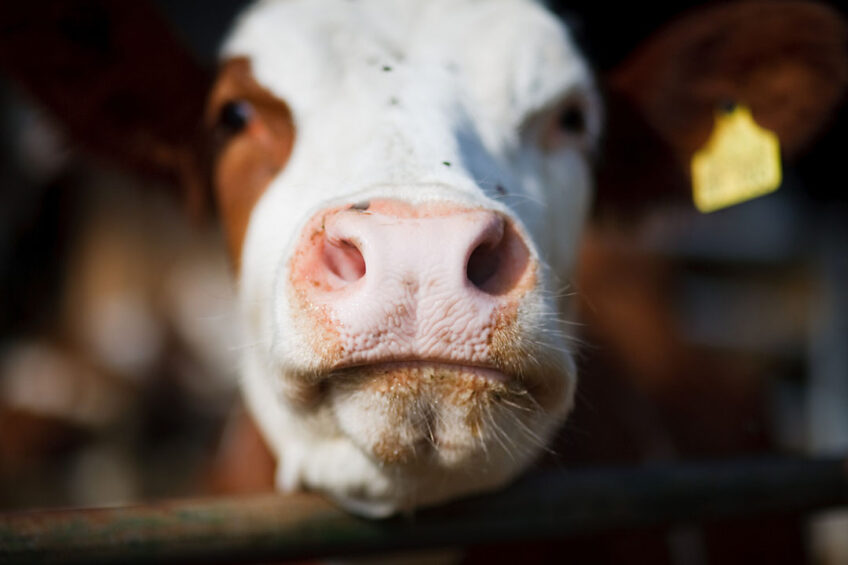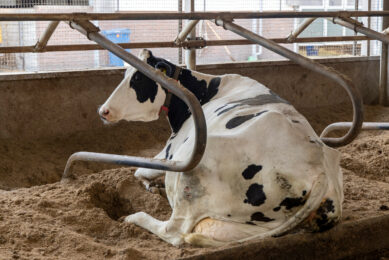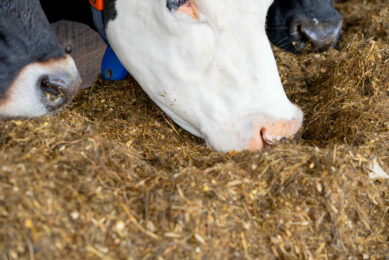Early tooth wear in dairy cattle

Early tooth wear may occur under certain conditions. Therefore, understanding the wear processes that affect animal performance will potentially lead to the prevention of future dental issues in the animals.
Cattle teeth are primarily composed of 2 different materials, namely enamel and dentin, both of which serve as a means of mastication and chewing of feed material, with the aid of the muscular pad in the upper part of the mouth. The enamel makes up the hard outer layer of the tooth that is visible outside of the gums. Enamel is also considered the hardest mineral. Dentin is a hard, light yellow material creating a porous layer of tissue directly underneath the enamel and cementum. Dentin is the material that makes up the largest portion of the tooth; it is comprised of crystals of phosphate and calcium, is softer than the enamel, yet still harder than bone.

Teeth erupt sequentially at different intervals from birth and are thus used for dentition until a certain age and are then naturally worn up to the point where cows are culled due to the reduced feed utilisation and animal productivity with advanced age. Early tooth wear may, however, occur under certain conditions. Therefore, understanding the wear processes that affect animal performance will potentially lead to the prevention of future dental issues in the animals.
Plant factors
Grasses and other pasture plants often contain various amounts of phytoliths or plant stones (minute mineral particles formed inside the plant tissues) which erode the dentin in the teeth as the animal chews the plant material. This effect is more pronounced in the late stages of plant maturity where the level of these mineral particles increases to 15% compared to the normal range of 3% at the early stages of plant maturity.
Animal factors
There is existing evidence that digestive and other health issues may be risk factors for some types of bovine dental problems. While laminitis itself is not known to cause dental issues, there does seem to be some overlap between laminitic animals and those more prone to excessive tooth wear. Periodontal disease can also contribute as much as 5x to other dental conditions. If a cow is not grazing or doing enough chewing during feeding times, it can result in food packing, bacteria growth, and other nasty things that can contribute to periodontal disease. Tooth wear may also be genetically mediated and special precautions will be needed in this case to avoid the spread of the problem from one generation to another.
Effects on the animal
Clinical signs
The following are the most common clinical symptoms observed in cows having tooth wear problem:
- Painful lesions in the mouth
- Irregular and sharp molars causing injuries to the tongue and cheek
- Different lateral movements of the jaws
- Irregularities in the shedding of temporary teeth, which delays the eruption of the permanent teeth or may alter their direction
- Abnormal position and direction of teeth, causing injury to the soft tissues to which they come in contact
- Dental tumor involving gingiva at the dental border of or the interdental spaces
- Imperfect grinding of feed
- Foul-smelling if the mouth
DM intake
Mastication efficiency is crucial to digestion processes and subsequent energy gain among ruminants. Tooth wear alters the occlusal surface topography, causing a gradual loss of functionality. This suggests that directional changes in digestive processes may occur since increased particle size is likely to increase reticulo-rumen retention times and reduce DM intake. Also, teeth problems are often associated with pain or discomfort, as indicated above, which results in absence of appetite, capriciousness in feeding, or other disturbances.
Milk yield and composition
With the decreased DM intake, milk yield is reduced. There is also a reduced rumination time in cases of tooth wear, which is often associated with low milk production (r = 0.37 to 0.69 depending on parity and DM intake). With the decreased chewing activity and rumination time, there is a change of the acetate: propionate ratio which decreases from 2.0 to 1.3 when a typical diet containing 70% roughage and 30% concentrates is fed to the dairy cow. The reason for this change in rumen fermentation is not clear. Conceivably, it may be related to a change in the rumen microbial population or a shift in the metabolism of existing microbes toward less acetate and more propionate production under low rumen buffering conditions. It may also result from the increased rumen fluid dilution rate due to the increased flow of water into the rumen as an attempt to adjust rumen osmolality. In either case, there is a decrease in milk fat percentage since acetate is the main precursor of milk fat synthesis
Control measures
Dental care of cows should always be employed and duly observed throughout the production cycle. Reference may be made here to the following points:
- Application of glycerine to the oral cavity
- Irrigating the mouth with potassium permanganate solution and/or other disinfectants
- Use of antibiotics, with the type and dosage thereof to be decided by a specialized veterinarian
- Surgical operations, if required
Dental care is especially important in cases where cows are grazing late matured pasture plants or in dry seasons where large amounts of phytoliths are formed in the plant tissues. Dental care should, in this case, avoid many of the intake and production problems associated with tooth wear.
In cases where tooth wear results from endocrine disorders, infected animals should not be used for breeding purposes as the condition is usually hereditary.
References are available upon request.
Join 13,000+ subscribers
Subscribe to our newsletter to stay updated about all the need-to-know content in the dairy sector, two times a week.










